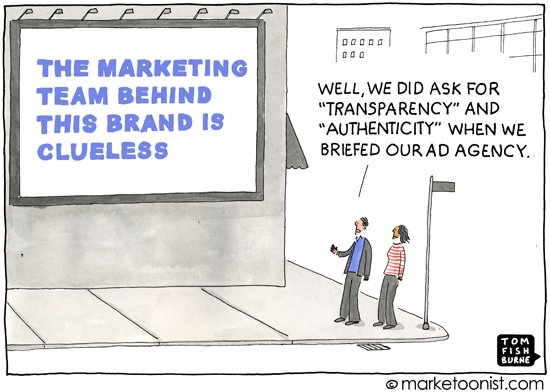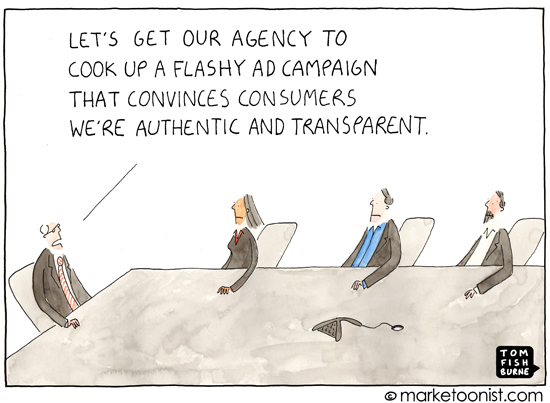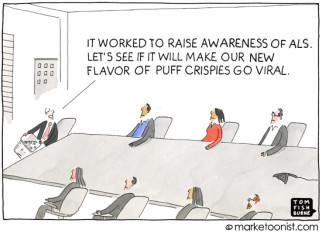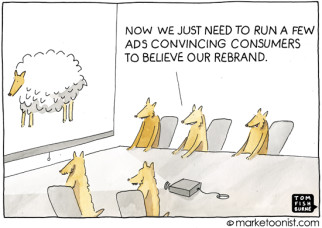Marketers are increasingly pushing for “transparency” and “authenticity” in their brand communication. But, for many brands, this is surface-deep. They want advertising that makes them look authentic and transparent without actually being authentic and transparent.
Filmmaker Johan Liedgren wrote a snarky satirical open letter replying to a request to produce “authentic” looking commercials for a brand:
“I count no less than 14 instances of the word “authentic” in the brief. Counting synonyms like “real,” “true,” “genuine,” “not fake,” and “actual,” the tally rises to 28 … I don’t view the opportunistic call for “authenticity” as a hope for a our industry, but rather as an all-time low point for a trade that is no stranger to constantly lowered ambitions for the communication between organizations and real humans. Why? Because you don’t really want authenticity.”
The more you have to shout about how authentic your brand is, the less it probably is. Much of authenticity advertising is authenticity washing. It’s boasting about authenticity without really practicing it. Practicing it requires far more of the organization than the marketing department.
Scott Monty at Ford Motor wrote an interesting article earlier this year about transparency and authenticity in business, focusing on a case study from McDonald’s Canada.
McDonald’s faced an online rumor that its Chicken McNuggets were made from “pink goop”, along with a photo circulating on the internet claiming to show the process. Rather than combat the rumor with a faux-authentic commercial of chicken farmers in a bucolic setting, they filmed their entire supply chain and manufacturing process and shared it step-by-step. So far, that video has been seen nearly 4.4 million times. This was all part of a McDonald’s Canada program called “Our Food. Your Questions” that has answered 20,000 questions from consumers with this level of candor since 2012.
This program may be transparent, but does this lead to authenticity? McDonald’s after all was the target of Morgan Spurlock’s Super Size Me 10 years ago. They’ve struggled with an authenticity gap, which is why consumers believed the “pink goop” story in the first place. But the McDonald’s brand in Canada saw a 60% increase in brand trust as a result of this program. That’s an important step in the right direction for the brand.
McDonald’s Australia launched a related program called “Track My Macca” that let’s you track all of the ingredients in the food you’re about to eat, using the GPS from your phone to track a particular McDonald’s outlet, a QR code on the food packaging, and the time you received the food to tell you the origin of each ingredient, from the lettuce to the farm that supplied the beef.
That story reveals the potential that many brands see in advertising with transparency and authenticity. But it also shows how it requires much more than a marketing comms campaign. It takes the full organization. Consumers can see right through shallow marketing spin and authenticity washing. To work, it has to go deeper.
Transparency and authenticity require far more than a brief to an agency. I’d love to hear your thoughts here.
Here’s a cartoon I posted on this topic last year.
(Marketoonist Monday: I’m giving away a signed cartoon print. Just share an insightful comment to this week’s post by 5:00 PST on Monday. Thanks!)




Mads Gorm Larsen says
But you keep asking how to be “transparent” and “authentic”, should we not ask if “transparent” and “authentic” is in fact the best way for a company to sell. Is Malboro going to sell more cigarets by being “transparent” and “authentic”?
Valerie Lambert says
This brought to mind the scene in “A Fish Called Wanda,” when Kevin Kline and Jamie Lee Curtis were opening the safe to take the jewels for themselves (and Jamie was about to bludgeon Kevin), only to find that George had already moved the loot and the safe was empty. (!!)
Otto (Kevin) started ranting and screaming, “W-H-A-T do you have to DO to make people TRUST you?!?!?!”
I think many brands/marketers are the same: “We’re interested in ripping you off, but W-H-A-T do we have to do to get you to TRUST us?!”
Malcolm Webber says
Yes, authenticity is a must! It’s not just a matter of talking the talk; you must also tweet the tweet!
XavMod says
Being “Authentic” involves the whole organization in the McDonald’s cases: long-term investment of M$.
But brand can be authentic in a guerilla-approach with the involvement of the marketing team, that’s the example of Blissel Canada
https://www.youtube.com/watch?v=NHznDFD3V3k
I don’t seen a proof of result, but I’m quite sure that it may have the same effect than McDonald’s…with far fewer $ invested.
Chris Boone says
Transparent and authentic are buzzwords du jour indeed. In marketing there is a way to build transparency by building brand connection. Telling your brand’s story in a way that somehow connects people emotionally will make them feel like part of the brand’s “family.” Every family has a black sheep so a strong connection will counteract adversity. Authenticity in my opinion means being true to the brand – either you were the first on the market, the innovator or original and the value proposition is “Hey, we created this thing that you love. Why would you buy an imitation?” Or if you are a “me too” product you embrace that while you were not the first, you made something better and tell your story from there.
Stephen says
Authenticity is the key. If you can fake that, you’ve got it made. (Not sure of the source!)
Mike A.T. Edwards (@mikeATedwards) says
You can be an authentic rogue, or a transparent fool. Both are perceptions since we can never physically ‘know’ a brand – whether it’s Richard Branson or Branson pickle. Only those organisations genuinely open to scrutiny, and in genuinely competitive environments need apply.
Connie says
I think the problem is right there in the brief-you have to “create” authenticity. The problem is that authenticity really comes down from “doing” not “creating”.
What I think brands do well that do the authenticity bit is that they go hard core into something and make the sale about the person and their skills. Nike comes to mind – all of the Nike products are about pushing people’s skills to be better, and they regularly meet with athletes and study performance in order to get it right. When you say Nike, people think of athletes – and that’s who their brand is.
Even Martha Stewart really has a bit of the authenticity vibe going for her – you know when you make something called the “best chocolate cake” that it will be a really darn good chocolate cake. And you know all her minions are scurrying to find those recipes for you. 😉
I think that’s why the McDonald’s campaign worked so well – it went back to what they do best – make burgers and chicken nuggets, so that’s why it clicked as authentic, whereas Taco Bell’s “no really, we make our tacos with beef” campaign came off as unbelieveable shtick.
Sean says
Very good writeup, but not the one I expected given the cartoon! What that cartoon most reminds me of vis-a-vis authenticity was one ad I saw for a technical/geek T-shirt design. The design itself showed the artist was “in the know” as it were. Anyone in the target market who simply saw the shirt would have been inclined to buy it just by seeing it. However, the description blurb accompanying the design on the actual purchasing page read quite blatantly like some generic design marketing guru had read and edited-for-enthusiasm the copy written by the non-technical copy writer who was creating a pitch based on the cliff notes of the mildly technical rep who had interviewed the artist on why the design was so good. The end result was that rather than coming across as a hip authentic geek T-shirt company connecting geek designers with geek consumers, they came across as an oblivious generic outlet just trying to make a quick buck off whoever came in the door.